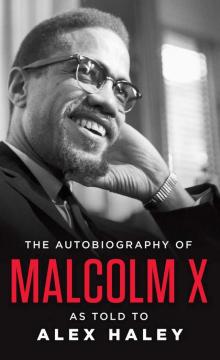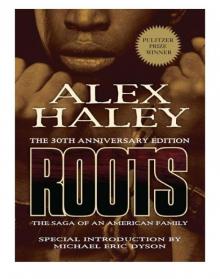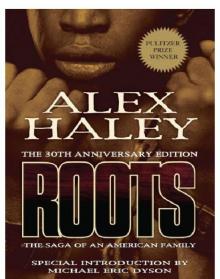- Home
- Alex Haley
Roots: The Saga of an American Family
Roots: The Saga of an American Family Read online
Table of Contents
ROOTS:
Title Page
Dedication
Acknowledgements
HALEY’S COMET
CHAPTER 1
CHAPTER 2
CHAPTER 3
CHAPTER 4
CHAPTER 5
CHAPTER 6
CHAPTER 7
CHAPTER 8
CHAPTER 9
CHAPTER 10
CHAPTER 11
CHAPTER 12
CHAPTER 13
CHAPTER 14
CHAPTER 15
CHAPTER 16
CHAPTER 17
CHAPTER 18
CHAPTER 19
CHAPTER 20
CHAPTER 21
CHAPTER 22
CHAPTER 23
CHAPTER 24
CHAPTER 25
CHAPTER 26
CHAPTER 27
CHAPTER 28
CHAPTER 29
CHAPTER 30
CHAPTER 31
CHAPTER 32
CHAPTER 33
CHAPTER 34
CHAPTER 35
CHAPTER 36
CHAPTER 37
CHAPTER 38
CHAPTER 39
CHAPTER 40
CHAPTER 41
CHAPTER 42
CHAPTER 43
CHAPTER 44
CHAPTER 45
CHAPTER 46
CHAPTER 47
CHAPTER 48
CHAPTER 49
CHAPTER 50
CHAPTER 51
CHAPTER 52
CHAPTER 53
CHAPTER 54
CHAPTER 55
CHAPTER 56
CHAPTER 57
CHAPTER 58
CHAPTER 59
CHAPTER 60
CHAPTER 61
CHAPTER 62
CHAPTER 63
CHAPTER 64
CHAPTER 65
CHAPTER 66
CHAPTER 67
CHAPTER 68
CHAPTER 69
CHAPTER 70
CHAPTER 71
CHAPTER 72
CHAPTER 73
CHAPTER 74
CHAPTER 75
CHAPTER 76
CHAPTER 77
CHAPTER 78
CHAPTER 79
CHAPTER 80
CHAPTER 81
CHAPTER 82
CHAPTER 83
CHAPTER 84
CHAPTER 85
CHAPTER 86
CHAPTER 87
CHAPTER 88
CHAPTER 89
CHAPTER 90
CHAPTER 91
CHAPTER 92
CHAPTER 93
CHAPTER 94
CHAPTER 95
CHAPTER 96
CHAPTER 97
CHAPTER 98
CHAPTER 99
CHAPTER 100
CHAPTER 101
CHAPTER 102
CHAPTER 103
CHAPTER 104
CHAPTER 105
CHAPTER 106
CHAPTER 107
CHAPTER 108
CHAPTER 109
CHAPTER 110
CHAPTER 111
CHAPTER 112
CHAPTER 113
CHAPTER 114
CHAPTER 115
CHAPTER 116
CHAPTER 117
CHAPTER 118
CHAPTER 119
CHAPTER 120
ALEX HALEY
Copyright Page
ROOTS:
The 30th Anniversary Edition
PUBLISHER’S STATEMENT
One of the most important books and television series ever to appear, Roots, galvanized the nation, and created an extraordinary political, racial, social and cultural dialogue that hadn’t been seen since the publication of Uncle Tom’s Cabin. The book sold over one million copies in the first year, and the miniseries was watched by an astonishing 130 million people. It also won both the Pulitzer Prize and the National Book Award. Roots opened up the minds of Americans of all colors and faiths to one of the darkest and most painful parts of America’s past.
Over the years, both Roots and Alex Haley have attracted controversy, which comes with the territory for trailblazing, iconic books, particularly on the topic of race. Some of the criticism results from whether ROOTS is fact or fiction and whether Alex Haley confused these two issues, a subject he addresses directly in the book. There is also the fact that Haley was sued for plagiarism when it was discovered that several dozen paragraphs in Roots were taken directly from a novel, The African, by Harold Courlander, who ultimately received a substantial financial settlement at the end of the case.
But none of the controversy affects the basic issue. Roots fostered a remarkable dialogue about not just the past, but the then present day 1970s and how America had fared since the days portrayed in Roots. Vanguard Press feels that it is important to publish Roots: The 30th Anniversary Edition to remind the generation that originally read it that there are issues that still need to be discussed and debated, and to introduce to a new and younger generation, a book that will help them understand, perhaps for the first time, the reality of what took place during the time of Roots.
Vanguard Press
A Member of the Perseus Books Group
DEDICATION
It wasn’t planned that Roots’ researching and writing finally would take twelve years. Just by chance it is being published in the Bicentennial Year of the United States. So I dedicate Roots as a birthday offering to my country within which most of Roots happened.
ACKNOWLEDGMENTS
I owe deep gratitude to so many people for their help with Roots that pages would be required simply to list them all. The following are pre-eminent:
George Sims, my lifelong friend from our Henning, Tennessee, boyhood, is a master researcher who often traveled with me, sharing both the physical and emotional adventures. His dedicated combing through volumes by the hundreds, and other kinds of documents by the thousands—particularly in the U. S. Library of Congress and the U. S. National Archives—supplied much of the historical and cultural material that I have woven around the lives of the people in this book.
Murray Fisher had been my editor for years at Playboy magazine when I solicited his clinical expertise to help me structure this book from a seeming impassable maze of researched materials. After we had established Roots’ pattern of chapters, next the story line was developed, which he then shepherded throughout. Finally, in the book’s pressurized completion phase, he even drafted some of Roots’ scenes, and his brilliant editing pen steadily tightened the book’s great length.
The Africa section of this book exists in its detail only because at a crucial time Mrs. DeWitt Wallace and the editors of the Reader’s Digest shared and supported my intense wish to explore if my maternal family’s treasured oral history might possibly be documented back into Africa where all black Americans began.
Nor would this book exist in its fullness without the help of those scores of dedicated librarians and archivists in some fifty-seven different repositories of information on three continents. I found that if a librarian or archivist becomes excited with your own fervor of research, they can turn into sleuths to aid your quests.
I owe a great debt to Paul R. Reynolds, doyen of literary agents—whose client I have the pleasure to be—and to Doubleday Senior Editors Lisa Drew and Ken McCormick, all of whom have patiently shared and salved my frustrations across the years of producing Roots.
Finally, I acknowledge immense debt to the griots of Africa—where today it is rightly said that when a griot dies, it is as if a library has burned to the ground. The griots symbolize how all human ancestry goes back to some place, and some time, where
there was no writing. Then, the memories and the mouths of ancient elders was the only way that early histories of mankind got passed along ... for all of us today to know who we are.
HALEY’S COMET
By Michael Eric Dyson
From the very beginning, Alex Haley’s Roots counted as much more than a mere book. It tapped deeply into the black American hunger for an African ancestral home that had been savaged by centuries of slavery and racial dislocation. More than the sum of its historical and literary parts—some of which have been rigorously criticized and debunked—Haley’s quest for his roots changed the way black folk thought about themselves and how white America viewed them. No longer were we genealogical nomads with little hope of learning the names and identities of the people from whose loins and culture we sprang. Haley wrote black folk into the book of American heritage and gave us the confidence to believe that we could find our forebears even as he shared his own. Kunta and Kizzy—and Chicken George too—became members of our black American family. That’s why no flaw or shortcoming in Haley’s tome could dim the brilliant light he shed on the black soul. Haley’s monumental achievement helped convince the nation that the black story is the American story. He also made it clear that black humanity is a shining beacon that miraculously endured slavery’s brutal horrors.
I was a seventeen-year-old boarding school student when Haley’s comet of a book hit the nation’s racial landscape. It immediately changed the course of our conversations around school and provided a powerful lens onto a period of history that few of us really understood. Until Haley’s book, there was little public grappling with the drama of American slavery. Of course, the epochal television miniseries that grew from Haley’s text seized us in its thrilling exploration of chattel slavery’s vast and vicious evolution. The book and miniseries also sparked the phenomenon of black self-discovery. For too long, slavery had been an American terror that left the lives of black folk scarred by memories of pain and humiliation. Haley’s book brought black folk out of the shadows of shame and ignorance. It also spurred many of us for the first time to speak openly and honestly about the lingering effects of centuries-old oppression. If the black freedom struggle of the ’60s had liberated our bodies from the haunting imperatives of white supremacy, Haley’s book helped free our minds and spirits from that same force.
Roots also prodded white America to reject the racial amnesia that fed its moral immaturity and its racial irresponsibility. As long as there was no book or image that captured slavery’s disfiguring reach, the nation could conduct its business as if all racial problems had been solved when it finally bestowed civil rights on its black citizens. But Haley helped us to resist that seductive lie with a tonic splash of colorful truth: that the nation had yet to successfully negotiate its perilous ties to an institution that built white prosperity while crushing black opportunity. Roots was a soulful reminder that unless we grappled with the past, we would be forever saddled by its deadening liabilities. Since it was published during the nation’s blithely romantic celebration of its bicentennial, Haley’s book provided a touchstone for alternative history. Haley’s book helped conscientious citizens to challenge the self-image of America as an unqualified champion of democracy and freedom.
The true impact of Haley’s book is that it started a conversation about black roots that continues to this day. DNA tests to determine black ancestry are more popular than ever. Scientific advance is part of the explanation, but the cultural impetus for such an agenda of racial discovery lies with Haley’s inspiring book. It is also fitting that Roots appeared the same year that Black History Week was officially extended to Black History Month. Haley’s crowning achievement came along at just the right time to prompt the investigation of black folks’ noble and complex contributions to national culture. Haley’s Roots sparked curiosity among ordinary citizens by making the intricate relations between race, politics and culture eminently accessible. Long before demands for history from the bottom up became a rallying cry of progressive historians, Haley’s book practiced what it preached. And if he made missteps along the way, he nevertheless put millions of us on the right path to racial and historical knowledge that shaped our reckoning with the color line. Few books can claim such an impressive pedigree of influence.
Alex Haley’s Roots is unquestionably one of the nation’s seminal texts. It affected events far beyond its pages and was a literary North Star that guided us through the long midnight of slavery’s haunting presence. Roots is an exercise in the skillful telling of a people’s pilgrimage through the quagmire of lost racial links to the solid ground of recovered connections. For that reason alone, it is to be celebrated as a classic of American ambition and black striving. Each generation must make up its own mind about how it will navigate the treacherous waters of our nation’s racial sin. And each generation must overcome our social ills through greater knowledge and decisive action. Roots is a stirring reminder that we can achieve these goals only if we look history squarely in the face.
CHAPTER 1
Early in the spring of 1750, in the village of Juffure, four days upriver from the coast of The Gambia, West Africa, a man-child was born to Omoro and Binta Kinte. Forcing forth from Binta’s strong young body, he was as black as she was, flecked and slippery with Binta’s blood, and he was bawling. The two wrinkled midwives, old Nyo Boto and the baby’s Grandmother Yaisa, saw that it was a boy and laughed with joy. According to the forefathers, a boy firstborn presaged the special blessings of Allah not only upon the parents but also upon the parents’ families; and there was the prideful knowledge that the name of Kinte would thus be both distinguished and perpetuated.
It was the hour before the first crowing of the cocks, and along with Nyo Boto and Grandma Yaisa’s chatterings, the first sound the child heard was the muted, rhythmic bomp-a-bomp-a-bomp of wooden pestles as the other women of the village pounded couscous grain in their mortars, preparing the traditional breakfast of porridge that was cooked in earthen pots over a fire built among three rocks.
The thin blue smoke went curling up pungent and pleasant, over the small dusty village of round mud huts as the nasal wailing of Kajali Demba, the village alimamo, began, calling men to the first of the five daily prayers that had been offered up to Allah for as long as anyone living could remember. Hastening from their beds of bamboo cane and cured hides into their rough cotton tunics, the men of the village filed briskly to the praying place, where the alimamo led the worship: “Allahu Akbar! Ashadu an lailahailala!” (God is great! I bear witness that there is only one God!) It was after this, as the men were returning toward their home compounds for breakfast, that Omoro rushed among them, beaming and excited, to tell them of his firstborn son. Congratulating him, all of the men echoed the omens of good fortune.
Each man, back in his own hut, accepted a calabash of porridge from his wife. Returning to their kitchens in the rear of the compound, the wives fed next their children, and finally themselves. When they had finished eating, the men took up their short, bent-handled hoes, whose wooden blades had been sheathed with metal by the village blacksmith, and set off for their day’s work of preparing the land for farming of the groundnuts and the couscous and cotton that were the primary men’s crops, as rice was that of the women, in this hot, lush savanna country of The Gambia.
By ancient custom, for the next seven days, there was but a single task with which Omoro would seriously occupy himself: the selection of a name for his firstborn son. It would have to be a name rich with history and with promise, for the people of his tribe—the Mandinkas—believed that a child would develop seven of the characteristics of whomever or whatever he was named for.
On behalf of himself and Binta, during this week of thinking, Omoro visited every household in Juffure, and invited each family to the naming ceremony of the newborn child, traditionally on the eighth day of his life. On that day, like his father and his father’s father, this new son would become a member of the tribe.
&nbs
p; When the eighth day arrived, the villagers gathered in the early morning before the hut of Omoro and Binta. On their heads, the women of both families brought calabash containers of ceremonial sour milk and sweet munko cakes of pounded rice and honey. Karamo Silla, the jaliba of the village, was there with his tan-tang drums; and the alimamo, and the arafang, Brima Cesay, who would some day be the child’s teacher; and also Omoro’s two brothers, Janneh and Saloum, who had journeyed from far away to attend the ceremony when the drumtalk news of their nephew’s birth had reached them.
As Binta proudly held her new infant, a small patch of his first hair was shaved off, as was always done on this day, and all of the women exclaimed at how well formed the baby was. Then they quieted as the jaliba began to beat his drums. The alimamo said a prayer over the calabashes of sour milk and munko cakes, and as he prayed, each guest touched a calabash brim with his or her right hand, as a gesture of respect for the food. Then the alimamo turned to pray over the infant, entreating Allah to grant him long life, success in bringing credit and pride and many children to his family, to his village, to his tribe—and, finally, the strength and the spirit to deserve and to bring honor to the name he was about to receive.
Omoro then walked out before all of the assembled people of the village. Moving to his wife’s side, he lifted up the infant and, as all watched, whispered three times into his son’s ear the name he had chosen for him. It was the first time the name had ever been spoken as this child’s name, for Omoro’s people felt that each human being should be the first to know who he was.
The tan-tang drum resounded again; and now Omoro whispered the name into the ear of Binta, and Binta smiled with pride and pleasure. Then Omoro whispered the name to the arafang, who stood before the villagers.
“The first child of Omoro and Binta Kinte is named Kunta!” cried Brima Cesay.
As everyone knew, it was the middle name of the child’s late grandfather, Kairaba Kunta Kinte, who had come from his native Mauretania into The Gambia, where he had saved the people of Juffure from a famine, married Grandma Yaisa, and then served Juffure honorably till his death as the village’s holy man.

 The Autobiography of Malcolm X: As Told to Alex Haley
The Autobiography of Malcolm X: As Told to Alex Haley Roots: The Saga of an American Family
Roots: The Saga of an American Family Roots
Roots